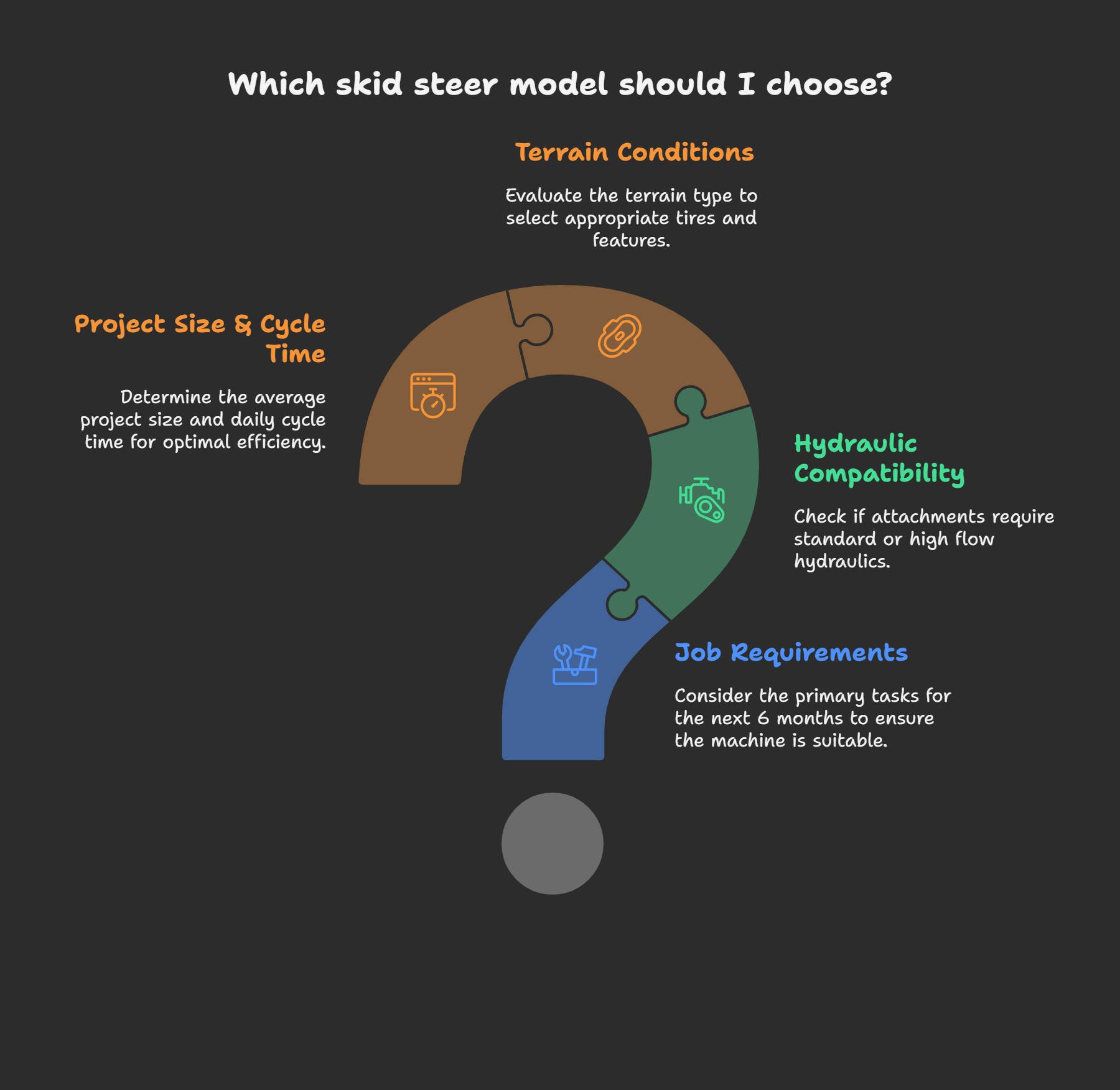The Hidden Truth About Skid Steer Performance and Horsepower
On one side, horsepower is a question that is often leading in the mind of the user while searching the best skid steer loader. Just because one does not exactly know what it is, the buyer is simply forced to grab the most powerful of the machines available on the market by taking for granted an idea like “more horsepower equals more performance.”
However, truth to be told, in most cases, the companies will be using less than half of the built-in power of the skid steer performance, thus wasting money, fuel, and time in equal measure. Instead of continuing with the old narrative “the bigger the better,” why not delve a bit more into what hp is really telling about your business?
What Skid Steer Loader Horsepower Should Be?
Fundamentally speaking, horsepower (HP) defines the amount of work that can be done by an engine in a specific time frame. However, in the story of skid steer loaders, horsepower seems to be very distant from the actual skid steer performance of the machine at the job site. The question is:
what are the reasons? The answer is simple – the hydraulic flow (GPM), torque, and attachment efficiency have in some instances more importance.
- Engine horsepower is a term defining the set of operations in which the engine is being used to produce the necessary power without any limitations or restrictions.
- Hydraulic horsepower is the source of energy for the movement of an object by a given machine; this is the main reason why many buyers are being deceived.
- Operational horsepower can be limited, e.g., due to the environment, capacity of a machine, or even traction.
For this reason, even though it is attractive to consider horsepower as a single number expressing a base level of performance, in reality, it is often a partial story.
The Misconception: Higher Horsepower Means Better Skid Steer Performance
The notion that more horsepower leads to better skid steer performance is a marketing myth that is always present in equipment advertisements and the words of salespeople. Most of the time it makes one buy a machine that is too big for the job and thus waste money.
- A larger engine consumes more fuel than necessary, thus your operating costs become bigger without reasons.
- A bigger machine requires more money for high transport and takes up more space in storage.
- It is like to “drive a tank” in the case of power being too high, which in turn will make the operator lose control of the work, especially in precision tasks such as landscaping and snow removal.
A buyer of a machine shouldn’t be fixed on horsepower alone but rather he/she should look at job-specific performance metrics.
When You’re Paying for Power You Don’t Use – Skid Steer Performance
The horsepower rating of 90–100+ for skid steer loaders sounds great, and the machine may seem powerful enough for anything, but in reality, most of the everyday tasks can be solved using less power. So the decision of whether the horsepower of a skid steer should be bought higher or not can turn into a problem of the size of the solution rather than its strength.
- A residential landscaping, snow removal, or grading job needing less than 60–70 HP can be next to the most common type of work in those areas.
- Agricultural and light construction activities are usually more effective when the hydraulic flow is used than the engine power.
- Hydraulic GPM and PSI, not raw HP, is what products like augers, trenchers, and sweepers work on.
| Task Type | Suggested HP Range | Hydraulic Flow (GPM) Needed |
| Landscaping | 50–65 HP | 16–20 GPM |
| Construction (light duty) | 60–75 HP | 18–22 GPM |
| Heavy construction | 75–100+ HP | 25+ GPM |
The Hidden Costs of Extra Horsepower
Apart from the higher buying price, bigger skid steers are accompanied by hidden costs which gradually reduce your return on investment. Many owners don’t know that they are making a big mistake just because they are overpowered.
- More fuel consumption is one of the reasons you can increase your operating costs a lot.
- Maintenance on powerful engines is more demanding and costly.
- Besides, insurance and transport permits could also become more costly.
| Task Type | Suggested HP Range | Hydraulic Flow (GPM) Needed |
| Landscaping | 50–65 HP | 16–20 GPM |
| Construction (light duty) | 60–75 HP | 18–22 GPM |
| Heavy construction | 75–100+ HP | 25+ GPM |
When you see the total sum, these figures become large, especially for small contractors or seasonal operations.
When High Horsepower Is Actually Necessary
Actually, there are some cases where high horsepower is a prerequisite. It is not only a matter of overkill, but rather a rule of thumb, where power is productivity. However, the main thing which effects skid steer performance is to be able to recognize the exact moment.
- Overly-loaded heavy construction with recurring utilization of high-demand power units like planers or stump grinders, for example.
- Backcountry or sideway lands matter, with the extra power to crash the resistance and slopes relief.
- Four or more shifts enterprises, of work where time and load efficiency are major factors of the output.
As a result, if you are going through everyday procedures that heavily load your skid steer, you might as well be owning a justified investment of 95+ HP.
Matching Horsepower to Attachments and Hydraulic Needs
What really puts the skid steer performance over the top is your hydraulic system. Almost all the flow rate (GPM) and pressure (PSI) based appliances (breakers, mowers, tillers, augers, etc.) depend on, are the hydraulics and not the raw engine horsepower. So a well-appointed 70 HP skid steer with high-flow hydraulics can be better than a 90 HP unit with standard flow.
- Standard Flow: ~16–22 GPM (Suitable for basic tasks and small attachments)
- High Flow: ~25–38 GPM (Required for heavy-duty attachments such as mulchers or trenchers)
- Advanced High Flow (XPS/Hi-Flow): Up to 45 GPM in some select models
| Cost Factor | 65 HP Skid Steer | 95 HP Skid Steer |
| Avg. Fuel Use/Hour | 2.5 gallons | 4.2 gallons |
| Annual Fuel Cost (est.) | $5,200 | $8,736 |
| Annual Maintenance | $1,500 | $2,300 |

Choosing the Right Skid Steer: Questions to Ask
Never jump into buying your next skid steer loader right away. Instead, take a moment to look at the situation from a different angle. Don’t just compare the HP; rather, ask yourself these practical questions:
- What are the 5 main jobs I will use the machine for during the next 6 months?
- Do my hydraulic attachments work with standard or high flow?
- Am I going to work on soft soil, in tight spaces, or on delicate terrain?
- How big is my average project and what is my daily cycle time?
Many times, a machine that is fit-for-purpose and thus not an overkill will be able to save you tens of thousands of dollars in the long run.
Conclusion: Right-Size Your Skid Steer for Real Results
The belief that skidding machines with higher horsepower will give you better skid steer performance, has kept many businesses from overspend on machines that outsize their needs. In the case of skid steer loader horsepower, a lower but more efficient work is better than a high one. Rather than being obsessed with the number of HP, you should take into account the conditions at your work site, the requirements of the attachment, the comfort of the operator, and the total cost of ownership.
Turn horsepower into a strategic decision—never a feature of pride.
Do you need assistance in selecting the best skid steer loader for your operation? Get in touch with the professionals, and we will help you find a machine that will be as efficient as you are—without hurting your budget resulting in effective skid steer performance in every project. We are here to help you make the smartest lift of your career.
FAQs About Skid Steer Loader Performance and Horsepower
How much horsepower do I actually need in a skid steer?
Typically, 60–75 HP skid steers can do most light-to-moderate work. Power machines of 90+ HP are the right ones if it is a heavy attachment or a continuous-duty task.
Does more horsepower mean better skid steer performance?
No, just engine size is not the only factor that affects the performance of a machine. Performance is influenced by hydraulic flow, traction, and attachment compatibility.
What’s more important—hydraulic flow or engine HP?
Generally, for an operation with an attachment, it is better to have hydraulic flow (GPM) rather than power of the engine.
Will a high-horsepower skid steer performance last longer?
The time of life depends mostly on the care of the machine and where it is used, not on the power of the machine only.
Do smaller skid steers handle attachments as well?
Surely, if the hydraulic system is suitable for the work. Many compact models are already equipped with import flow kits.
Can I retrofit a high-flow system to a low HP skid steer?
Of course, it can be done, but it will be costly and may not achieve the same level of skid steer performance as a unit designed for that function.
Are higher HP skid steers harder to operate?
They usually have more weight and less maneuverability in limited areas, which can make them harder to be controlled.

Nice read, I just passed this onto a friend who was doing a little research on that. And he actually bought me lunch because I found it for him smile So let me rephrase that: Thank you for lunch!
Excellent web site. Lots of helpful information here. I’m sending it to a few pals ans also sharing in delicious. And obviously, thanks for your sweat!
Have you ever considered about including a little bit more than just your articles? I mean, what you say is fundamental and everything. But just imagine if you added some great photos or videos to give your posts more, “pop”! Your content is excellent but with images and videos, this blog could certainly be one of the very best in its field. Fantastic blog!
Thanks for this post, I am a big big fan of this web site would like to proceed updated.
Hey There. I found your blog using msn. This is a really well written article. I will be sure to bookmark it and come back to read more of your useful info. Thanks for the post. I will definitely return.